Ethiopian Airlines
 |
||||
|
||||
| Founded | 1945 | |||
|---|---|---|---|---|
| Hubs | Bole International Airport | |||
| Frequent-flyer program | Sheba Miles | |||
| Fleet size | 45 (+49 orders) | |||
| Destinations | 74 (57 international and 17 domestic) [1] | |||
| Company slogan | Africa's World Class Airline | |||
| Headquarters | Bole International Airport Addis Ababa, Ethiopia |
|||
| Key people | Seyoum Mesfin (Chairman), Girma Wake (CEO) | |||
| Website | www.ethiopianairlines.com | |||
Ethopian Airlines (Amharic: የኢትዮጵያ አየር መንገድ; የኢትዮጵያ? in short) is an airline headquartered on the grounds of Bole International Airport in Addis Ababa, Ethiopia.[2] It is the national airline of Ethiopia,operating scheduled international passenger and freight services to over 57 destinations worldwide, as well as domestic services to 17 destinations and passenger and cargo charter flights. Its main site is the Bole International Airport.[3] Ethiopian Airlines serves over 50 destinations worldwide and over 35 destinations within Ethiopia.[4]
Contents |
History
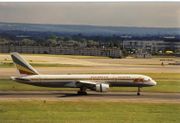
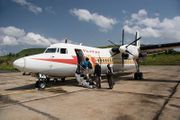
Ethiopian Airlines was founded on December 29, 1945, by Emperor Haile Selassie with assistance from TWA. It commenced operations on April 8, 1946, with a weekly service between Addis Ababa and Cairo with five Douglas DC-3 propeller-driven aircraft.[5]
The airline started long-haul services to Frankfurt in 1958 and inaugurated its first jet service in January 1963 from Addis Ababa to Nairobi. In 1965, it changed from a corporation to a share company and changed its name from Ethiopian Air Lines to Ethiopian Airlines. In the early 1960s it provided some initial aviation support to the Ethiopia-United States Mapping Mission in its operation to provide topographic maps of Ethiopia.[6] It is wholly owned by the government of Ethiopia and has 4,700 employees (at March 2007)[3].
Although it relied on American pilots and technicians at the beginning, by its 25th anniversary in 1971 Ethiopian Airlines was managed and staffed by Ethiopian personnel. In 1998, it started transatlantic services. The airline was featured by The Economist as an example of excellence in late 1987,[7] and Ethiopianist Paul B. Henze recognized it in 2000 as being "one of the most reliable and profitable airlines in the Third World",[8] In 2007, Ethiopia Airlines provided basic pilot and aviation maintenance training to trainees from African countries including Rwanda, Tanzania, Chad, Djibouti, Madagascar and Sudan. Other training was given to employees of Kenya Airways, Air Zimbabwe, Bellview Airlines, Cape Verde Airlines and Air Madagascar.[9]
The airline provided service to the Eritrean capital of Asmara until a war erupted between the two countries in 1998. The airline calls its frequent flyer program "Sheba Miles" in reference to the legendary Queen of Sheba.
Financial performance
Ethiopian Airlines started "Vision 2020" in 2005 which aimed to increase passenger traffic to 3 million, revenue to 1 billion US dollars and the staff to 6,000. In its fiscal year 2007/2008, the airline transported 2.5 million passengers and generated 9.2 billion birr revenue (USD 900 million) with a net profit of 507 million birr (USD 56 million).[10]
For the fiscal year 2008/2009, ET transported 2.8 million passengers (a 12.3% increase y/y) generated 12.2 billion birr in revenue (USD 980 million - a 32.8% increase y/y) with a net profit of 1.345 billion birr (108 million USD - a 165% increase over the previous year). In the same period, Ethiopian hauled 101 thousand tons of cargo, a 38.4% increase over the previous year.[11] These results are the best yet for the 64 year old airline, and were attributed to an aggressive marketing campaign and major cost cutting measures.[12]
Destinations
Fleet
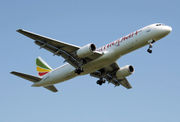
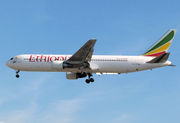
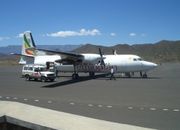
The Ethiopian Airlines fleet includes the following aircraft (at 25 January 2010):[13][14][15]
Passenger
| Aircraft | In Fleet | Orders | Options | Passengers (Cloud Nine/Economy) |
Notes | |
|---|---|---|---|---|---|---|
| Airbus A350-900 | 0 | 12 | 0 | Entry into service: 2017 | ||
| Boeing 737-700 | 7 | 0 | 0 | 118 (16/102) | 2 operating for Asky Air | |
| Boeing 737-800 | 2 | 10 | 0 | 154 (16/138) | ||
| Boeing 757-200 | 8 | 0 | 0 | 160 (16/144) 169 (16/153) 170 (16/154) 171 (16/155) 175 (16/159) |
||
| Boeing 767-300ER | 11 | 0 | 0 | 220 (30/190) 225 (30/195) 232 (24/208) 235 (24/211) 245 (24/221) |
||
| Boeing 777-200LR | 0 | 5 | 0 | 321(34/287) | Entry into service: December 2010 | |
| Boeing 787-8 | 0 | 10 | 2 | Entry into service: Mid 2011 | ||
| Bombardier Dash 8 Q400 | 6 | 2 | 4 | 78 (0/78) | ||
| Fokker 50 | 5 | 0 | 0 | 52 (0/52) | Replacement aircraft: Bombardier Dash 8 | |
| Diamond DA40NG | 0 | 10 | 0 | 4 (0/4) | Pilot Training Aircrafts | |
| Total | 39 | 49 | 6 |
Not counting the De Havilland planes, the fleet average age was 10.7 years at January 2008[16].
In February 2005 Ethiopian Airlines signed a preliminary agreement to buy up to 10 Boeing 787 Dreamliner aircraft (5 firm orders and 5 options). On 31 May 2005 Boeing announced that Ethiopian had exercised its purchase rights and confirmed a firm order for 10 aircraft. The new planes are expected to be delivered in 2011. Ethiopian Cargo operates two 757-200PCF, 2 MD-11F and 2 Boeing 747-200BCF. Three of the existing four passenger 757-200s are expected to be converted to freighter configuration.
Cargo
| Aircraft | Total | Orders | Notes |
|---|---|---|---|
| Boeing 747-200BCF | 2 | 0 | Operated by Southern Air |
| Boeing 757-200PCF | 2 | 0 | |
| McDonnell Douglas MD-11F | 2 | 0 | |
| Total | 6 | 0 |
Ethiopian Airlines is not part of one the three global airline alliances, but is preparing for membership of the Star Alliance.[17] It has codeshare agreements with the following airlines:[18]
 Air Nigeria
Air Nigeria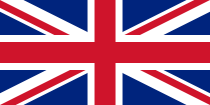 BMI (Star Alliance)
BMI (Star Alliance).svg.png) Brussels Airlines (Star Alliance) [19]
Brussels Airlines (Star Alliance) [19] Gulf Air [20]
Gulf Air [20] Kuwait Airways
Kuwait Airways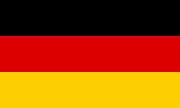 Lufthansa (Star Alliance) [21]
Lufthansa (Star Alliance) [21] RwandAir [22]
RwandAir [22]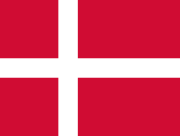
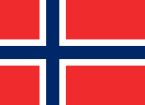
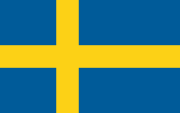 SAS (Star Alliance)
SAS (Star Alliance) Saudi Arabian Airlines [23]
Saudi Arabian Airlines [23] Singapore Airlines (Star Alliance) [17]
Singapore Airlines (Star Alliance) [17]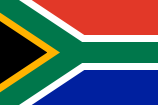 South African Airways (Star Alliance)
South African Airways (Star Alliance)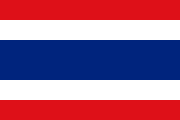 Thai (Star Alliance) [17]
Thai (Star Alliance) [17]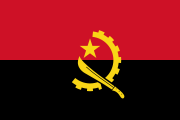 TAAG Angola Airlines
TAAG Angola Airlines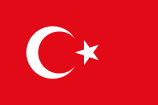 Turkish Airlines (Star Alliance) [24]
Turkish Airlines (Star Alliance) [24]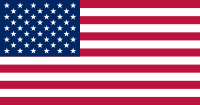 United Airlines (Star Alliance) [17]
United Airlines (Star Alliance) [17]
Ethiopian Airlines and Lufthansa have closely linked their frequent flyer programms Shebamiles and Miles & More [25] allowing members to earn and spend miles on the airlines' entire network.
In July 2008 Ethiopian Airlines entered a strategic partnership with Lomé based start-up airline ASKY Airlines in which Ethiopian holds a 25% stake [26][27]. Ethiopian Airlines is responsible for aircraft maintenance and operational management. The plan is to turn Lomé into Ethiopian Airline's regional hub for the West African market[17].
Incidents and accidents
The BBC stated that, contrast to many other African carriers, Ethiopian Airlines has a good safety record.[28]
On 15 July 1960, Ethiopian Airlines Flight 372 crashed into a mountainside killing one crew and injured 11 more.[1]
On 5 August 1974, Douglas C-47B ET-ABE was damaged beyond economic repair when it overshot the runway on landing at Mota Airport.[29]
On 20 November 1974, Douglas C-47A ET-AAR crashed on take-off from Soddu Airport. Two of the 24 people on board were killed. The aircraft was operating a domestic scheduled passenger flight to Beica Airport.[30]
On 14 March 1975, Douglas C-47 ET-ABR was destroyed on the ground at Lalibela Airport during a clash with rebels.[31]
On 11 September 1975, Douglas C-47 ET-ABX crashed into Choke Mountain near Mota killing one of the nine people on board. The aircraft was on a domestic scheduled passenger flight from Bahar Dar Airport to Debre Marqos Airport.[32]
On 23 April 1976, Douglas C-47A ET-AAS was damaged beyond economic repair at Massawa Airport.[33]
On 31 May 1976, Douglas C-47B ET-ADC was destroyed by fire after an explosion whilst taxiing at Massawa Airport.[34]
On 14 December 1976, Douglas C-47B ET-AEJ was damaged beyond economic repair when the undercarriage collapsed on landing at Oborso Airport. The aircraft was on a scheduled passenger flight. All eight people on board survived.[35]
On 25 April 1977, a Douglas DC-3 was hijacked on a flight from Alula Aba Airport, Mek'ele to Gondar Airport. Three people were killed, and the hijackers were overpowered.[36]
On 12 June 1977, Douglas C-47A ET-AAP was reported to have been damaged beyond economic repair in a landing accident at Kabri Dar Airport, Kebri Dahar when the port undercarriage collapsed.[37]
On 20 July 1977, Douglas R4D-1 ET-ABF crashed into a mountain near Tubo Milkie whilst on a domestic cargo flight from Tippi Airport to Jimma Airport. All five people on board were killed.[38]
On 14 August 1977, Douglas C-47A ET-AAP was reportedly shot down at Massawa.[37]
On 15 October 1978, Douglas C-47A ET-AGK was damaged beyond economic repair in a landing accident at Soddu Airport following a hydraulic system failure. The aircraft was on a domestic scheduled passenger flight. All 32 people on board survived.[39]
On 25 October 1978, Douglas C-47A ET-AGQ was damaged beyond economic repair in a landing accident at Degahbur Airport. Although the aircraft was on a cargo flight, it was carrying nine passengers and four crew, all of whom survived.[40]
On 28 January 1979, Douglas C-47 ET-AGP was damaged beyond economic repair in an accident at Heycota, Eritrea. Three people were killed.[41]
On 19 February 1979, Douglas C-47 ET-AFW crashed at Barentu Airport, Eritrea after a bomb exploded on board. All five people on board the aircraft were killed.[42]
On 20 April 1979, Douglas C-47A ET-AGU was substantially damaged in a landing accident at Oborso Airport, Ethiopia. The aircraft was repaired and returned to service.[43]
On 21 September 1979, Douglas C-47A ET-AGU was damaged beyond economic repair in a take-off accident at Barentu Airport, Eritrea.[44]
On 18 March 1980, Douglas C-47B ET-AGM crashed whilst on a single engined approach to Bole International Airport, Addis Ababa. The aircraft was on a training flight.[45]
On 11 January 1981, Douglas-C47A ET-AGW was damaged beyond repair when the port undercarriage collapsed on landing at Bahir Dar Airport.[46]
On 7 October 1981, Douglas C-47A ET-AHR was damaged beyond repair at Combolcha Airport, Dessie when the undercarriage collapsed on landing. The aircraft was destroyed in December 1981 when a Mil Mi-24 helicopter crashed into it.[47]
On 22 August 1982, Douglas DC-3 ET-AHP was damaged beyond repair in a take-off accident at Alula Aba Airport.[48]
On 2 May 1987, Douglas C-47A ET-AGT was destroyed on the ground at Axum Airport in an attack on the airport by Ethiopian Air Force MiG-23s.[49]
On 15 September 1988, Ethiopian Airlines Flight 604, a Boeing 737-200 registered ET-AJA, ingested pigeons into both engines shortly after take off from Bahir Dar, Ethiopia. One engine lost thrust almost immediately and the second lost thrust during the emergency return to the airport. During the crash landing, 31 of the 105 passengers were killed [2].
On 23 November 1996, Ethiopian Airlines Flight 961, a Boeing 767-200ER registered ET-AIZ, was hijacked by three hijackers. The flight was on its first leg of an Addis Ababa-Nairobi-Brazzaville-Lagos-Abidjan route. The hijackers instructed the pilot to fly to Australia. As the aircraft flew south along the African coast, Air Traffic Controller at Nairobi advised the crew to land at Mombasa. Fuel ran out and one of the plane's engines stopped. They attempted a landing into shallow waters 500 meters from shore near Le Galawa Beach (near Moroni in the Comoros Islands). 123 of the 175 passengers and crew died, including Kenyan photojournalist Mohamed Amin and all of the hijackers. The aircraft was destroyed.
On 25 January 2010, Ethiopian Airlines Flight 409, a Boeing 737-800 registered ET-ANB, crashed shortly after take off from Beirut Rafic Hariri International Airport en route to Bole International Airport in Addis Ababa, Ethiopia. The aircraft was carrying 82 passengers and 8 crew members, and all 90 people were reported dead.[50][51] The airline reported 82 passengers and 8 crew members, and the local government reported 83 passengers, and 7 crew members.[52]. A permanent memorial web site has been designed to receive condolence messages to the victims and their families [3]. Surface recovery efforts are being conducted by Lebanese and US naval forces. The Lebanese government has contracted Odyssey Marine, a treasure hunting company, to recover the black boxes, which were reported found on 7 February 2010 [53].
Accreditation
The United States Federal Aviation Administration accredited the maintenance division with license No. ETIY 102F.[54][55]
References
- ↑ http://nazret.com/blog/index.php?title=ethiopia_ethiopian_airlines_and_star_all&more=1&c=1&tb=1&pb=1
- ↑ "Company Profile." Ethiopian Airlines. Retrieved on 3 October 2009.
- ↑ 3.0 3.1 Flight International 3 April 2007
- ↑ http://www.ethiopianairlines.com/en/network/domestic/default.aspx
- ↑ Camerapix, Spectrum Guide to Ethiopia (Brooklyn: Interlink, 2000), p. 296
- ↑ Ethiopia-United States Mapping Mission web site
- ↑ "In Search of Excellence, the Hard Way", The Economist, 31 December 1987.
- ↑ Paul B. Henze, Layers of Time: A History of Ethiopia, (New York: Palgrave, 2000), p. 246.
- ↑ "Annual Report 2006/2007" (accessed 3 February 2009)
- ↑ http://www.ethiopianairlines.com/news/report.aspx?nid=206
- ↑ http://www.ethiopianairlines.com/en/news/pressreleases.aspx?hl=%20235
- ↑ "Ethiopian Airlines 08/09 net profit leaps 165 pct". Reuters. 7 August 2009. http://www.reuters.com/article/rbssIndustryMaterialsUtilitiesNews/idUSL729887520090807.
- ↑ Ethiopian Airlines Fleet
- ↑ Ethiopian Airlines Fleet at airfleets.net. Retrieved 2010-01-12.
- ↑ Ethiopian Airlines fleet list at ch-aviation.ch. Retrieved 2010-01-25.
- ↑ Ethiopian Airlines Fleet Age
- ↑ 17.0 17.1 17.2 17.3 17.4 "National Airline Soars Despite Global Turbulence - 08 June, 2009
- ↑ "Ethiopian - Company Profile
- ↑ "Ethiopian and Brussels Set to Launch Codeshare Agreement - 12 June 2008
- ↑ "Ethiopian and Gulf Air Enter Code Share Agreement - 18 July 2007
- ↑ "Ethiopian Strengthens Codeshare with Lufthansa - 1 December 2008
- ↑ "RWANDAIR SIGNS CODESHARE WITH ETHIOPIA - 10 September 2009
- ↑ "Ethiopian Enters Codeshare with Saudi Arabian Airlines - 5 December 2008
- ↑ "Ethiopian, Turkish Airlines negotiate code sharing
- ↑ "Shebamiles and Miles and More Partnership
- ↑ "Ethiopian and ASKY Airlines Sign MoU on Strategic Partnership and Investment - 01 July, 2008
- ↑ "Ethiopian Airlines and ASKY Sign a Management Contract - 16 January, 2009
- ↑ "Ethiopian Airlines jet crashes into sea off Beirut". BBC News. 25 January 2010. http://news.bbc.co.uk/1/hi/world/middle_east/8478060.stm. Retrieved 25 January 2010.
- ↑ "ET-ABE Accident description". Aviation Safety Network. http://aviation-safety.net/database/record.php?id=19740805-2. Retrieved 24 August 2010.
- ↑ "ET-AAR Accident description". Aviation Safety Network. http://aviation-safety.net/database/record.php?id=19741120-1. Retrieved 24 August 2010.
- ↑ "ET-ABR Accident description". Aviation Safety Network. http://aviation-safety.net/database/record.php?id=19750314-0. Retrieved 20 August 2010.
- ↑ "ET-ABX Accident description". Aviation Safety Network. http://aviation-safety.net/database/record.php?id=19750911-1. Retrieved 21 August 2010.
- ↑ "ET-AAS Accident description". Aviation Safety Network. http://aviation-safety.net/database/record.php?id=19760423-0. Retrieved 15 August 2010.
- ↑ "ET-ADC Accident description". Aviation Safety Network. http://aviation-safety.net/database/record.php?id=19760531-0. Retrieved 15 August 2010.
- ↑ "ET-AEJ Accident description". Aviation Safety Network. http://aviation-safety.net/database/record.php?id=19761214-0. Retrieved 15 August 2010.
- ↑ "Hijacking description". Aviation Safety Network. http://aviation-safety.net/database/record.php?id=19770425-0. Retrieved 4 August 2010.
- ↑ 37.0 37.1 "ET-AAP Accident description". Aviation Safety Network. http://aviation-safety.net/database/record.php?id=19770612-1. Retrieved 4 August 2010.
- ↑ "ET-ABF Accident description". Aviation Safety Network. http://aviation-safety.net/database/record.php?id=19770720-0. Retrieved 5 August 2010.
- ↑ "ET-AGK Accident description". Aviation Safety Network. http://aviation-safety.net/database/record.php?id=19781015-2. Retrieved 1 August 2010.
- ↑ "ET-AGQ Accident description". Aviation Safety Network. http://aviation-safety.net/database/record.php?id=19780000-0. Retrieved 1 August 2010.
- ↑ "ET-AGP Accident description". Aviation Safety Network. http://aviation-safety.net/database/record.php?id=19790128-1. Retrieved 29 July 2010.
- ↑ "ET-AFW Criminal occurrence description". Aviation Safety Network. http://aviation-safety.net/database/record.php?id=19790219-2. Retrieved 29 July 2010.
- ↑ "ET-AGU Accident description". Aviation Safety Network. http://aviation-safety.net/database/record.php?id=19790420-0. Retrieved 29 July 2010.
- ↑ "ET-AGU Accident description". Aviation Safety Network. http://aviation-safety.net/database/record.php?id=19790921-1. Retrieved 29 July 2010.
- ↑ "ET-AGM Accident description". Aviation Safety Network. http://aviation-safety.net/database/record.php?id=19800318-0. Retrieved 24 July 2010.
- ↑ "ET-AGW Accident description". Aviation Safety Network. http://aviation-safety.net/database/record.php?id=19810111-0. Retrieved 24 July 2010.
- ↑ "ET-AHR Accident description". Aviation Safety Network. http://aviation-safety.net/database/record.php?id=19811007-0. Retrieved 24 July 2010.
- ↑ "ET-AHP Accident report". Aviation Safety Network. http://aviation-safety.net/database/record.php?id=19820822-0. Retrieved 25 July 2010.
- ↑ "ET-AGT Criminal Occurrence description". Aviation Safety Network. http://aviation-safety.net/database/record.php?id=19880502-0. Retrieved 27 July 2010.
- ↑ "Ethiopian plane crashes off Beirut, 90 feared dead". Reuters. 25 January 2010. http://www.reuters.com/article/idUSTRE60O08T20100125.
- ↑ http://www.avherald.com/h?article=4264b8d5&opt=0
- ↑ http://www.dailystar.com.lb/article.asp?edition_id=1&categ_id=2&article_id=111089
- ↑ "Lebanon retrieves jet black box". BBC News. 7 February 2010. http://news.bbc.co.uk/2/hi/middle_east/8502741.stm. Retrieved 2 May 2010.
- ↑ "Approval & Accreditation," Ethiopian Airlines
- ↑ "Ethiopian Airlines Pioneer of African Aviation Industry," Ethiopian Government
External links
|
||||||||||||||||||||||||||||||||||||||||||||||||||||||||||||||||||
|
|||||